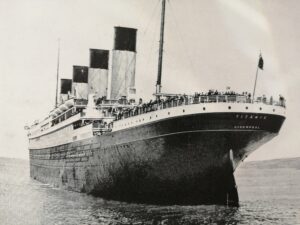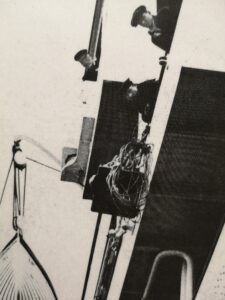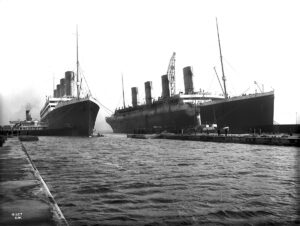Today, 11 April 2025, marks the 113th anniversary of the final port of call of White Star Line’s flagship, RMS Titanic, before heading out across the Atlantic (as in the last known photo above, by Kate Odell). Four days later she met her infamous demise after colliding with an iceberg and sinking on 15 April 1912.
Titanic dropped anchor at 11.30am at Roches Point, Ireland, outside Queenstown (now Cobh) and its great natural harbour. Then the world’s largest manmade moving object was on her way westward at 1.30pm to her fatal rendezvous with one of the world’s largest natural objects, never to see land again.

Maybe there were signs that all was not well with Titanic, owned and registered in Liverpool, with some 60% of her crew from the area. There was panic among some steerage passengers approaching on a tender at Queenstown when they saw a black figure rising out of the aft funnel’s rim, causing cries that this was the ‘Angel of Death’. In reality it was an off-duty soot-coated stoker enjoying this spectacular viewpoint.
Another visceral reaction was that of Titanic’s First Officer Henry Tingle Wilde, from Walton, Liverpool (right), drafted onboard at short notice. Not a man given to flights of fancy, apparently he wrote to his sister from Queenstown saying he had “a queer feeling about the ship”.
Liverpool (right), drafted onboard at short notice. Not a man given to flights of fancy, apparently he wrote to his sister from Queenstown saying he had “a queer feeling about the ship”.
A further 123 passengers boarded Titanic at Queenstown comprising three First Class, seven Second Class and 113 Third Class. Seven passengers took the overnight voyage from Southampton to Queenstown doubtless to relish a short taste of this maritime wonder.
Among the latter was the great Irish Edwardian photographer and Jesuit trainee Fr Francis Browne, who was a keen photographer and studiously recorded his short trip aboard Titanic, including another of the last known photographs of the ship.
 A Queenstown resident Mr McLean took the poignant final image of Capt Edward Smith (top left) looking down on the tender.
A Queenstown resident Mr McLean took the poignant final image of Capt Edward Smith (top left) looking down on the tender.
That final photograph of Titanic was taken by another cross-channel passenger, Kate Odell, who was fortunate to disembark and created this lasting memento of the liner steaming away into history, obviously unaware of the significance of her action.
A decidedly luckier stoker than the ‘Angel of Death’ was John Coffey, from Queenstown itself, who hid under mail bags being taken ashore to get home.
What has long fascinated me is the series of delays in Titanic’s construction that led to her tragic end in which more than 1,517 people were killed and only 706 survived.
The delays amounted to three weeks, postponing Titanic’s maiden voyage from 20 March 1912 to 10 April 1912. This time difference would have ensured that the iceberg was far north of Titanic’s course during her planned maiden voyage.
This was caused mishaps to RMS Olympic, Titanic’s elder sister (by one year). Olympic had to return twice to the liners’ builders Harland & Wolff in Belfast. First to repair damage after colliding with HMS Hawke on 20 September 1911, which entailed not only workers switched from fitting out Titanic but also cannibalising one of her propeller shafts.
return twice to the liners’ builders Harland & Wolff in Belfast. First to repair damage after colliding with HMS Hawke on 20 September 1911, which entailed not only workers switched from fitting out Titanic but also cannibalising one of her propeller shafts.
Secondly, Olympic needed a lost propeller blade replaced on 12 March 1912, further requiring workers from the unfinished Titanic. This was the last occasion on which the world’s two largest ships would meet (right, Titanic on right). Then Titanic’s sea trials were delayed by a day due to bad weather, although she maintained her schedule by cancelling the goodwill call at Liverpool.
 The tragic story of Titanic continues to grip the world, not least due to director James Cameron’s Hollywood blockbuster 1997 film Titanic. Cobh commemorates its connection with the doomed liner with a museum in the former White Star Line Office. On my visit a few years ago entry tickets carried a passenger’s name and on exit it is revealed if you ‘survived’ or not. My passenger didn’t.
The tragic story of Titanic continues to grip the world, not least due to director James Cameron’s Hollywood blockbuster 1997 film Titanic. Cobh commemorates its connection with the doomed liner with a museum in the former White Star Line Office. On my visit a few years ago entry tickets carried a passenger’s name and on exit it is revealed if you ‘survived’ or not. My passenger didn’t.
What of Henry Tingle Wilde? He didn’t survive either and went down with the ship. However, his name is commemorated on his family’s gravestone and obelisk, at Kirkdale Cemetery, Liverpool.
The engraving reads: “Also Captain Henry T. Wilde, RNR Acting Chief Officer Who Met His Death in the SS Titanic Disaster 15th April 1912 aged 38 years. ‘One of Britain’s Heroes’.”

